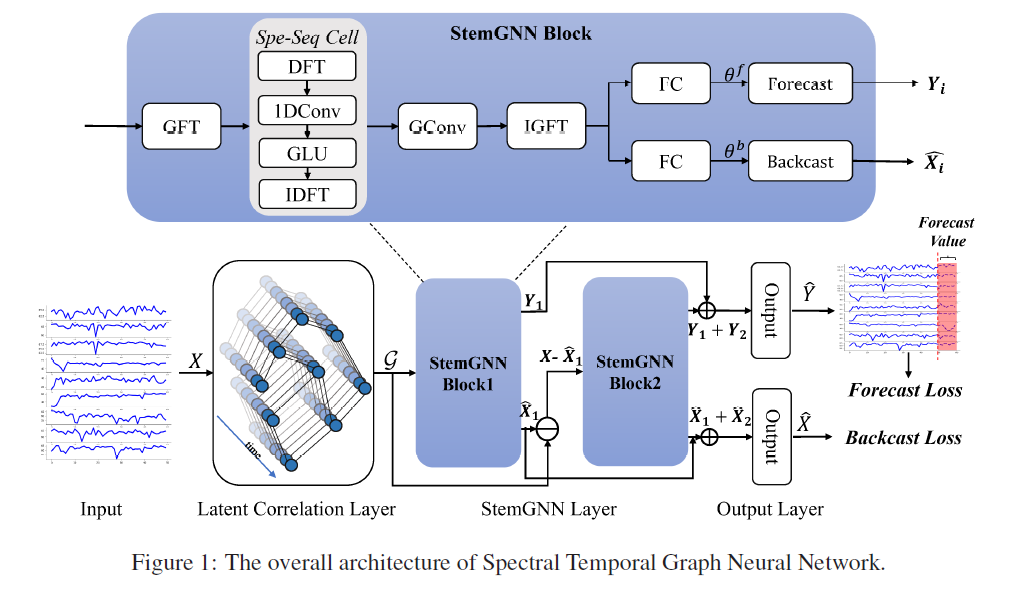Spectral Temporal GNN for MTS Forecasting (2021, 41)
Contents
- Abstract
- Introduction
- Related Work
- Problem Definition
- StemGNN ( Spectral Temporal GNN )
- Overview
- Latent Correlation Layer
- StemGNN Block
0. Abstract
Captures both
- 1) temporal correlations ( in time domain )
- 2) inter-series correlation
jointly, in the “spectral domain”
Combines
- 1) GFT (Graph Fourier Transform) \(\rightarrow\) inter-series correlation
- 2) DFT (Discrete Fourier Transform) \(\rightarrow\) temporal correlations
in an end-to-end framework
1. Introduction
previous works
- SFM (State Frequency Memory) network :
- combines DFT & LSTM for stock price prediction
- SR (Spectral Residual) model :
- leverages DFT in anomaly detection
- traffic forecasting
- model correlations among “multiple TS”
- ex) GCNs based models : stack GCN & temporal modules (LSTM,GRU)
- only caputre “temporal pattenrs” in time domain
- also, require pre-defined topology of inter-series relationshisp
This paper models
- 1) intra-series temporal patterns
- 2) inter-series temporal patterns
StepGNN
-
combines both DFT & GFT
- model MTS data in “spectral domain”
- spectral representations : clearer patterns & predicted more efficiently
- StemGNN block
- step 1) GFT : transfer structural MTS into “spectral TS”
- different trends can be decomposed to orthogonal TS
- step 2) DFT : transfer each univariate TS into “frequency domain”
- then, spectral representation becomes easier to be recognized by convolution & sequential modeling layers
- step 1) GFT : transfer structural MTS into “spectral TS”
- adopt both “forecasting & backcasting” output modules, with shared encoders
2. Related Work
MTS
- TCN
- treats high-dim data entirely as a tensor input
- considers a “large receptive field” through dilated CNN
- LSTNet
- CNN + RNN to extract…
- 1) short-term local dependence patterns among variables
- 2) long-term patterns of TS
- CNN + RNN to extract…
- DeepState
- state-space models with deep RNN
- DeepGLO
- leverages both global & local features during training/forecasting
- based on “matrix factorization”
MTS + GNN
-
DCRNN
- for traffic forecasting
- incorporate both “spatial & temporal” dependencies in convolutional RNN
-
ST-GCN
-
for traffic forecasting
-
integrates “graph convolution” & “gated temporal convolution”,
through “spatio-temporal convolutional blocks”
-
-
Graph WaveNet
-
combines graph convolutional layers with..
- “adaptive adjacency matrices”
- dilated causal convolutions
to capture “spatio-temporal dependencies”
-
\(\rightarrow\) but all those ignore “INTER-series correlation” ( or require dependency graph as priors )
& not in spectral domain
3. Problem Definition
Multivariate Temporal Graph : \(\mathcal{G}=(X, W)\)
- MTS input : \(X=\left\{x_{i t}\right\} \in \mathbb{R}^{N \times T}\).
- \(N\) : # of time series (nodes)
- \(T\) : # of time stamps
- \[X_{t} \in \mathbb{R}^{N}\]
- Adjacency matrix : \(W \in \mathbb{R}^{N \times N}\)
Task :
- input : previous \(K\) time stamps
- \(X_{t-K}, \cdots, X_{t-1}\).
- output : next \(H\) time stamps
- \(\hat{X}_{t}, \hat{X}_{t+1}, \cdots, \hat{X}_{t+H-1}\).
- model :
- \(\hat{X}_{t}, \hat{X}_{t+1} \ldots, \hat{X}_{t+H-1}=F\left(X_{t-K}, \ldots, X_{t-1} ; \mathcal{G} ; \Phi\right)\).
- \(F\) : forecasting model, with parameter \(\Phi\)
- \(\mathcal{G}\) : graph structure ( can be input as prior, or automatically inferred )
- \(\hat{X}_{t}, \hat{X}_{t+1} \ldots, \hat{X}_{t+H-1}=F\left(X_{t-K}, \ldots, X_{t-1} ; \mathcal{G} ; \Phi\right)\).
4. StemGNN ( Spectral Temporal GNN )
(1) Overview
StemGNN
- a general solution for MTS
- 3 steps
- 1) latent correlation layer
- input : \(X\)
- output : graph structure & weight matrix \(W\) is inferred
- 2) StemGNN Layer
- input : graph \(\mathcal{G}=(X,W)\)
- layer : consists of 2 residual StemGNN blocks
- designed to model “structural & temporal” dependencies inside MTS, in spectral domain
- 1) GFT
- 2) DFT
- 3) 1D conv & GLU sub layers
- 4) inverse DFT
- 5) graph convolution
- 6) inverse GFT
- designed to model “structural & temporal” dependencies inside MTS, in spectral domain
- 3) output layer
- composed of GLU & FC
- 2 kinds of output
- 1) forecasting outputs \(Y_i\)
- 2) backcasting outputs \(\hat{X_i}\)
- 1) latent correlation layer
- Loss Function
- \(\mathcal{L}\left(\hat{X}, X ; \Delta_{\theta}\right)=\sum_{t=0}^{T} \mid \mid \hat{X}_{t}-X_{t} \mid \mid _{2}^{2}+\sum_{t=K}^{T} \sum_{i=1}^{K} \mid \mid B_{t-i}(X)-X_{t-i} \mid \mid _{2}^{2}\).
- Inference : “rolling strategy for multi-step prediction”

(2) Latent Correlation Layer
Input : \(X \in \mathbb{R}^{N \times T}\)
Layer : GRU
- use the last hidden state \(R\) as the representation of entire TS
- calculate weight matrix \(W\) by self attention
- \(Q=R W^{Q}, K=R W^{K}, W=\operatorname{Softmax}\left(\frac{Q K^{T}}{\sqrt{d}}\right)\).
- \(W \in \mathbb{R}^{N \times N}\) : served as “adjacency matrix”
(3) StemGNN Block
( StemGNN layer = multiple StemGNN blocks + skip connections )
StemGNN Block
- designed by embedding a Spe-Seq (Spectral Sequential) Cell,
- into a Spectral Graph Convolution module
Described in picture above!
-
Spectral Graph Convolution : learn latent representation of MTS in spectral domain
-
GFT : capture inter-series relationships
- output of GFT is also MTS
-
DFT : capture repeated patterns in periodic data
( auto-correlation features among different time stamps )
